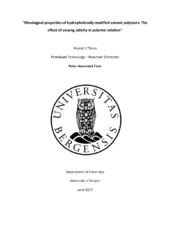Rheological properties of hydrophobically modified anionic polymers: The effect of varying salinity in polymer solution
Master thesis
Permanent lenke
https://hdl.handle.net/1956/16043Utgivelsesdato
2017-06-16Metadata
Vis full innførselSamlinger
Sammendrag
A new class of polymers, named ‘hydrophobically modified water-soluble polymers’, has been developed as an alternative to the more commonly used polyelectrolytes in enhanced oil recovery (EOR) applications. These polymers are very similar to conventional polymers used in EOR, except they have a small number of hydrophobic groups incorporated into the polymer backbone, making them more stable at high salinities. In this study we have investigated two hydrophobically modified anionic polymers. The polymers have the same backbone, including anionic content, equal amounts of hydrophobic substitution, but different chemical composition of the hydrophobes. Characterization of the polymers was performed using a combination of steady-state shear viscosity and dynamic oscillatory measurements. The shear viscosity and viscoelastic moduli were measured as the salinity increased. The results were compared to the corresponding anionic polymer without any hydrophobic substitution. As the salinity increased, the shear viscosity decreased for both the hydrophobically modified polyacrylamide and the partly hydrolysed polyacrylamide in the dilute regime. In the semi-dilute and concentrated regime, the shear viscosity initially decreased with increasing salinity before it increased at higher salinities (> 10 wt%). The lowest viscosities were observed between 5- and 10 wt% salinity. Above the critical overlap concentration, the hydrophobically modified polymer with the highest hydrophobe HLB generated much higher viscosities compared to its less hydrophobic analogue. The less hydrophobic polymer only showed higher viscosities than the polyacrylamide for salinities above 10 wt%. The elasticity of the most hydrophobic associative polymer remained relatively unaffected by increased salinity, showing the most elastic behaviour. The elasticity of the less hydrophobic polymer decreased at first as the salinity increased, reaching maximum viscous behaviour at 5 wt% salinity. At salinities > 5 wt%, the elasticity started to increase again. Both hydrophobically modified polymers displayed more elastic behaviour than the polyelectrolyte. This behaviour can increase oil recovery, mainly in high salinity and high permeability reservoirs through improved waterflood sweep efficiency due to enhanced viscosity increasing properties, and the microscopic displacement efficiency through its elasticity.
